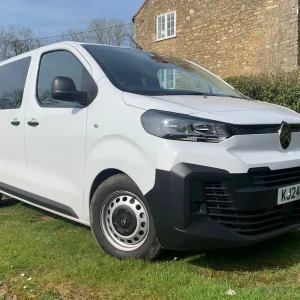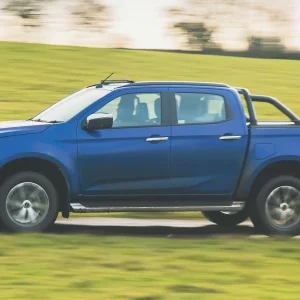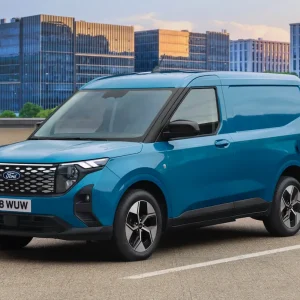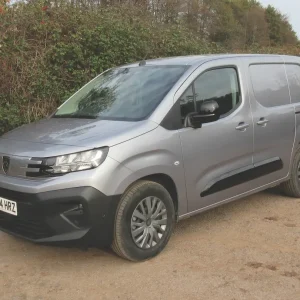Earlier this year Nissan introduced a revised version of its Navara 4×4 pick-up with a new six-speed manual transmission, multi-link rear suspension fitted to all models, and changes to its braking system.
Payload capacity is up by from 54kg to as much as 114kg depending on the model selected.
Improvements have been made to its in-cab connectivity and to its standard 2.3dCi diesel engine, offered at either 163hp or 190hp. The former now gets twin turbochargers, just like its more powerful stablemate. As a consequence its torque is up by 22Nm, to 425Nm.
As was the case previously you can order the Navara with either a two-door king cab or a four-door five-seater double cab, and yet again there is no shortage of trim levels.
Customers can pick from five: the specification walk begins with the Visia King Cab and finishes with the N-Guard Double Cab seven-speed automatic.
Cosmetic changes include new 17in and 18in alloy wheel designs and black bezel inlays for the LED headlamps.
So what’s the latest Navara like to drive? We decided to find out by sampling the Tekna Double Cab with the most powerful version of the 2.3-litre under its bonnet married to the six-speed manual box.

Load bay
Access to the cargo bay, which sits on a ladder-type frame, is by means of a hefty tailgate with a single, centrally mounted release handle. It drops down horizontally to reveal a load bed with a plastic liner and a set of moveable tie-down points mounted in tracking along the sidewalls and at the far end.
The presence of a bulky bumper and access step means the tailgate cannot be dropped down completely, a common characteristic of modern, purpose-built pick-ups. Roof rails are fitted should you require extra carrying capacity.

Interior and equipment
The Navara Tekna’s dashboard is dominated by an 8in touchscreen that gives access to a NissanConnect 2.0 entertainment and satellite navigation system. The package is compatible with Apple CarPlay and Android Auto.
Bluetooth connectivity is included in the deal, as is a DAB digital radio,
We found the satellite navigation system to be a little confusing, especially when it came to triggering the verbal instructions that tell you when to turn left or right.
Air-conditioning is installed as are electrically adjustable and heated exterior mirrors, electric windows in all four doors, driver and front passenger airbags, curtain airbags and a driver’s-knee airbag. Also on the list are a heated rear window and cruise control with a speed-limiter.
The radio’s remote controls are mounted on the height-adjustable steering wheel. The driver’s seat is electrically adjustable for height, reach and rake.
Storage facilities include a lidded bin between the front seats, which plays host to a 12V power socket. The bin is accompanied by a couple of cupholders. Another 12V socket plus a USB socket are mounted on the dash while a third 12V power point sits in a shelf on top of the dashboard.
Provided too are a lidded glovebox, bins and cupholders in all four doors and a cubbyhole at the bottom of the fascia. A holder for your sunglasses is mounted above the windscreen and you will find small pouches each side of the gear-lever console.
The seats are leather-trimmed and the ones in the front are heated. All five seats are equipped with headrests and lap-and-diagonal seatbelts. Legroom for the middle passenger in the back of the cabin is a little restricted, but the other two rear passengers should have less cause for complaint.
Chrome exterior door handles are fitted along with a chrome front grille and combined rear step and bumper, and the electrically folding exterior rear-view mirrors are housed in chrome casings.
The body is finished in metallic paint. Other exterior features include sill guards incorporating steps and front fog lights.
Intelligent Trailer Sway Assist is now fitted as standard across the range and responds if a trailer being towed starts to snake and looks as though it might turn over. It makes small corrections to the brake force applied to individual wheels and reduces engine torque at the same time, with the aim of bringing vehicle and trailer back under control.
Other safety features include brake assist, vehicle dynamic control (more usually referred to as an electronic stability programme) and a traction control system, which can be switched off. So can the truck’s stop/start system. Fitted too are intelligent emergency braking, hill-start assist, hill descent control and intelligent around-view monitor, which is invaluable.
Combined with the reversing camera, it gives you a bird’s-eye view of the vehicle to help prevent you from bumping into any obstructions during low-speed manoeuvring.
The Navara’s rear drum brakes have been scrapped in favour of 308mm discs and the front discs have been enlarged from 296mm to 320mm. Both sets of discs are ventilated. Double wishbone suspension is installed at the front along with a stabiliser bar while a five-link set-up with dual-stage springs and another stabiliser bar help to support the rear.
Our demonstrator vehicle sat on 18in black and silver alloy wheels shod with Continental ContiCrossContact LX 2 255/60 R18 tyres. The Navara’s rack-and-pinion steering is power-assisted.

Engine and gearbox
The four-cylinder 16-valve engine’s maximum power output bites at 3,750rpm while top torque of 450Nm kicks in at 1,500rpm. The compression ratio has fallen from 15.4 to 15.1 while fuel-injection pressure has risen from 2,000 to 2,200 bar with the adoption of a new pump.
The water cooling system has been updated too.
Thanks to the use of SCR – selective catalytic reduction – periodic doses of AdBlue are neededw to ensure compliance with Euro6 exhaust emission requirements. The AdBlue inlet point is to be found underneath a flap on the body’s offside. A particulate filter is fitted as well.
Driving
For a big pick-up the latest Navara handles remarkably well, a benefit that has to be attributed to the design of its suspension and the qualities of its Continental tyres. Tight bends can be tackled without having to worry that the truck’s back end will decide to swing out at an inopportune moment.
Unfortunately, the ride is not up to the standard of the handling. When the cargo box is empty you feel every bump – which at least prompts you to keep your speed in check – although everything calms down somewhat when you put a load on board. Things start to smooth out noticeably once you are half-laden.
With 190hp on tap you are not short of performance, and the power is poured on steadily as you accelerate. We had no major issues with the gear change or with in-cab noise levels.
Fuel economy? We were hitting an average 32mpg – about the same as the quoted WLTP combined phase maximum figure – on routes that included a fair amount of high-speed motorway work with plenty of weight onboard, not to mention a selection of Gloucestershire’s steeper and more demanding hills.
We can’t say we’re keen on the push-button starter, aware as we are that such arrangements are giving rise to growing security concerns across the industry. On a more positive note, the Navara’s four-wheel-drive system is easy to engage. All you need to do is twist a knob on the dashboard, then twist it again to engage a low-ratio set of gears.
It’s good to see our Navara had an electronic limited-slip differential, which can be turned on and off as needed.
We trundled around the damp and muddy paddocks of rural Herefordshire and up and down a slippery embankment or two without finding our progress halted. At no point did we have to resort to the lower set of gears, although it is always good to know they are there if you happen to need them.
Should you start bouncing around off-road then there are grab-handles on the A- and B-pillars for passengers to cling onto, and a compass on a display on the dashboard should help you find your way home if you get lost.
The level of ground clearance meant we had no grounds for concern when we splashed across a brook that was deeper and running more quickly than usual thanks to heavy rain. Wading depth is 600mm while minimum ground clearance is 223mm.

Operating
A generous five-year/100,000-mile warranty helps to hold down running costs while service intervals are set at two years/12,500 miles.
Admittedly that’s on the short side, but not unreasonably so if your truck spends most of its working life bouncing about off-road, and potentially ending up with suspension and steering damage.
Nissan Navara Tekna 4×4 Double-Cab pick-up
Price (ex VAT) £28,525
Price range (ex VAT) £22,150-£31,125
Gross payload 1,150kg
Load length 1,585mm
Load width (min/max) 1,130/1,560mm
Load bay height 474mm
Loading height 815mm
Gross vehicle weight 3,250kg
Braked trailer towing weight 3,500kg
Residual value 25.1%*
Cost per mile 58.6p
Engine size/power 2,298cc, 190hp @ 3,750rpm
Torque 450Nm @ 1,500rpm
Gearbox 6spd manual
Fuel economy 31.7mpg**
Fuel tank 73 litres
CO2 235g/km**
Warranty 5yrs/100,000mls
Service intervals 2yrs/12,500mls
Insurance group 40E
Price as tested £29,025
* after 4yrs/80,000mls; Source: KwikCarcost
** WLTP combined phase
Options Fitted
Metallic paint £500
Rivals
Ford Ranger
Price (ex VAT) £20,845-£39,895
Gross payload 1,059-1,307kg
Engines 130hp, 170hp, 213hp 2.0 diesel
Verdict: Recently extensively revised, the Ranger is attracting even more interest than it did previously, thanks largely to the extraordinary looking top-of-the-range Raptor. A 10-speed automatic gearbox is offered as an option – multi-speed auto boxes are becoming more common on light commercials – and Ford is not neglecting safety, with intelligent speed limiter and pre-collision assist with pedestrian detection listed as standard features.
Isuzu D-Max
Price (ex VAT) £16,094-£35,334
Gross payload 1,091-1,282kg
Engines 164hp 1.9 diesel
Verdict: A solidly constructed, no-nonsense workhorse, the Isuzu D-Max, What Van?’s Pick-Up of the Year for 2019, handles and rides competently and is offered with a wide choice of specifications. It’s good to see that the manufacturer sells two-door single-cab and extended-cab variants alongside the double-cab version given that so many pick-up manufacturers are concentrating solely on the double-cab market these days.
Ssangyong Musso
Price (ex VAT) £20,680-£28,930
Gross payload 1,085-1,095kg
Engines 181hp 2.2 diesel
Verdict: The cargo bed is on the short side, but all in all the Ssangyong Musso is an attractive package offered at a far more sensible price than some of its rivals. The positives include exemplary handling, a decent level of equipment and a generous warranty, but like most purpose-built pick-ups its unladen ride is not its strong suit. Fuel consumption, too, could be better.
The Final Verdict
|
Design |
8/10 |
Can be a load-shifter Mon-Fri and for personal use at weekends. |
|
Cabin |
8/10 |
Heated front seats help create comfortable working environment. |
|
Ride |
5/10 |
Unladen ride is poor, but improves markedly once over half fill. |
|
Refinement |
6/10 |
Noise levels are under control, but unladen ride disturbs the calm. |
|
Load area |
8/10 |
Like the moveable tie-down points, and payload is respectable. |
|
Handling/performance |
8/10 |
Both of a high standard, with the former particularly impressive. |
|
Engine/transmission |
8/10 |
A well-matched package. |
|
Standard equipment |
9/10 |
Pick Tekna and get pretty much every extra you’re likely to need. |
|
Operating costs |
7/10 |
Generous warranty. Short service intervals make sense. |
|
What Van? subjective rating |
7/10 |
Unladen ride isn’t great, but balance it against all the plus points. |





